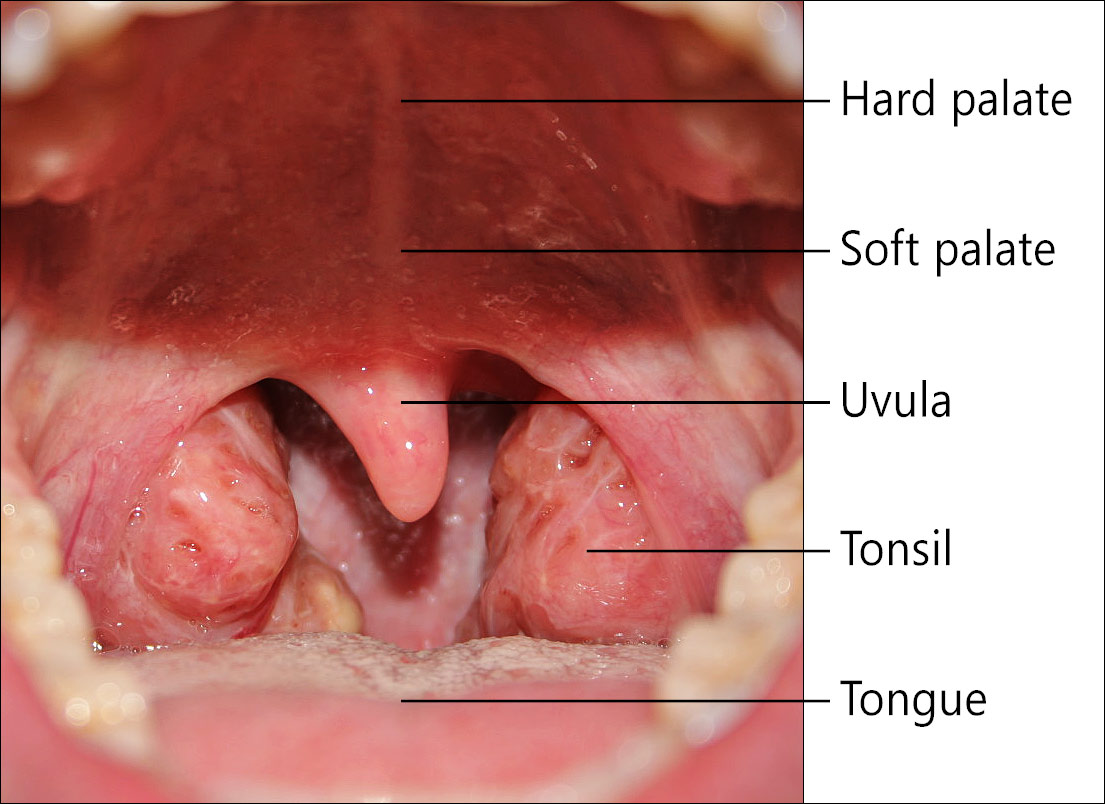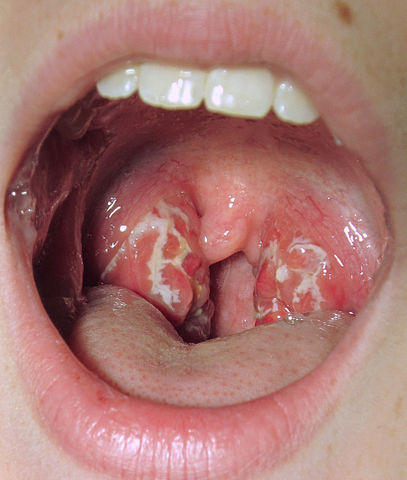Tonsillitis (Swollen Tonsils, Sore Throat Tonsils)
Most of us will experience a sore throat several times in life. It tends to come with the flu or a cold and often goes away in a few days without need for medication. In most of these cases we give little thought to what is happening in the throat. Located within the throat are small clumps of lymphoid tissue, a part of the immune system, known as tonsils. It traps germs like bacteria and viruses from the air that enters the throat and destroys it. Sometimes a sore throat is due to inflamed tonsils although the surrounding tissue of the throat is also usually inflamed.
What is tonsillitis?
Tonsillitis is inflammation of the tonsils in the throat. The term tonsillopharyngitis is often preferred because the tonsils as well as the surrounding tissue of the throat (pharynx) are affected at the same time. It is usually the tonsils that can be seen on either side at the back of the throat, known as the palatine tonsils, that are inflamed in tonsillopharyngitis. The tonsils at the back of the nose (adenoids) and tongue (lingual tonsils) which cannot be seen may also be affected. Tonsillitis is more common in children between 5 to 15 years of age and is one of the most common reasons for surgery in childhood.
Tonsillitis Reasons
Inflammation is a reaction when a part of the body is injured or damaged. With inflamed tonsils, it is the tissue of the throat that is affected. Air is moving through the throat all the time. The tonsils filter out the germs in the air and immune cells attack and destroy the germs. Some germs are highly pathogenic meaning that it causes disease very easily. Sometimes the tonsils are not able to effectively destroy the germs it filters. In these cases the tonsils become infected and inflamed.
Different types of chemicals are secreted by the injured tonsils and immune cells in the tonsils. This causes inflammation. Blood vessels in the tonsils widen (dilate), fluid flows into the tonsils making it swell and the tonsils become red and painful. Large amounts of immune cells congregate in the tonsils to fight off the infection and save the tissue from any damage. Tonsillitis is often thought of as a simple throat infection and in most cases it clears up quite easily anywhere within days to weeks. However, tonsillitis can be serious when complications arise. This occurs in severe cases or when it is left untreated.
Picture of the tonsils and parts of the throat from Wikimedia Commons
Acute Tonsillitis
Acute tonsillitis is a short bout of tonsil inflammation usually lasting a few days to 2 to 3 weeks at most. It arises very suddenly and becomes severe within a day or two. Complications are possible but uncommon in a child with a healthy immune system and no history of allergies or other conditions. Acute tonsillitis is usually viral and caused by the common cold viruses. Surgery is not usually considered for acute tonsillitis unless the swollen tonsils are affecting breathing and swallowing to a significant degree.
Chronic Tonsillitis
Chronic tonsillitis is when there is repeated bouts of acute tonsillitis. It is very rare for the inflammation to be continuous (persistent) in chronic tonsillitis. Chronic tonsillitis is determined by the person’s medical history and is defined by :
- seven or more bouts of acute tonsillitis in the past year.
- five or more bouts of acute tonsillitis in the past 2 years.
- four or more bouts of acute tonsillitis in in the past 3 years.
Surgery is the preferred treatment option as the tonsillar tissue becomes enlarged and damaged thereby allowing for bacterial infections which can be severe and are more likely lead to complications.
Tonsillitis Causes
Tonsillits is mostly caused by viruses and the common cold viruses in particular. Bacteria account for only 30% or less of acute tonsillitis cases. However, it is not uncommon for there to be a superimposed bacterial infection with viral tonsillitis.
Tonsillitis Viruses
- Adenovirus
- Cytomegalovirus
- Epstein-Barr virus (EBV)
- Herpes simplex virus (HSV)
- Influenza virus
- Measles virus
- Respiratory syncytial virus (RSV)
- Rhinovirus
Tonsillitis Bacteria
- Group A beta-hemolytic streptococcus (GABHS) – most common.
- Staphylococcus aureus
- Streptococcus pneumoniae
- Mycoplasma pneumoniae
- Chlamydia pneumoniae
Tonsillitis Symptoms
The main symptoms of tonsillitis are :
- Sore throat
- Difficulty swallowing
- Hoarse voice
- Fever
- Swollen lymph nodes
Sore Tonsils
The throat is typically painful with pain radiating to the ears (otalgia) and pain when swallowing (odynophagia). Younger children will typically refuse to eat and be restless. They may constantly interfere with he ears and complain of tenderness when touching the throat and jaw, mainly due to the tender and swollen lymph nodes. Hot drinks are not well tolerated as it tends to worsen the pain.
Swollen Tonsils
The swelling of the tonsils can vary in severity. The swollen palatine tonsils are clearly visible on either side of the throat when the mouth is opened wide. This cause difficulty with swallowing and a thicker and deeper tone to the voice. The swelling can be persistent even when the pain drastically reduces over time. If the swelling is very severe, surgery may be required even in acute tonsillitis.
Red Tonsils
Inflamed tonsils are red in color although this redness may extend to the surrounding tissue of the throat as well. Small red spots may be visible on the palate (roof of the mouth). There may be a white, gray or yellow membrane-like coating over the tonsils. Sometimes there may be open sores (ulcers) on the tonsils which are more intense red in color.
Picture of inflamed tonsils with white coating from Wikimedia Commons.
Other Tonsillitis Symptoms
Some of these symptoms may be due to tonsillitis itself or be part of the infection that causes tonsillitis.
- Bad breath
- Drooling
- Snoring
- Headache
- Neck stiffness
- Runny nose
- Stomachache (in young children)
Tonsillitis Diagnosis
The diagnosis of tonsillitis is made during a physical examination where the characteristic signs such as the red swollen tonsils can be seen by the doctor. The enlarged lymph nodes on the neck can also be palpated and the fever, if still present, will be recorded. Further tests may not be necessary but can include :
- Throat swab where a small sample of the secretions at the back of the throat are collected and sent for laboratory testing to identify the germ causing the infection. A culture or rapid antigen testing may be done with the sample.
- Blood tests like a complete blood count (CBC) or anti-streptococcal antibodies to identify the possible cause of the tonsillitis.
Differential Diagnosis
Several conditions may appear like tonsillitis or lead to tonsillitis. These conditions need to be identified so that treatment can be directed at the root cause. Some of these conditions include :
- Cancers of the head and neck
- Diphtheria
- Epiglottitis
- HIV infection
- Infectious mononucleosis
Tonsillitis Treatment
Milder cases of acute tonsillitis may not need any treatment. It is viral in nature and will resolve on its own within days. Hydration and rest is advised in these cases and gargles may be used although it has not been conclusively proven to be useful. Medication that may be used includes :
- Acetaminophen (paracetamol) and ibuprofen to control pain, swelling and fever.
- Antibiotics for bacterial infections of the tonsils but are not helpful for viral infections which are the main cause of tonsillitis.
- Corticosteroids are rarely used and reserved for severe cases of infectious mononucleosis causing tonsillitis.
Tonsillitis Surgery
Surgery is considered in chronic tonsillitis or even in acute cases where there are complications such as a peritonsillar abscess (quinsy), difficulty breathing or severe difficulty swallowing.
Tonsil Removal Methods
There are several methods for tonsil removal surgery (tonsillectomy). Some may be preferred for minimizing bleeding, others for its faster recovery time and even cost is a factor. There have been some methods that have fallen out of favor in recent years and are no longer used. Some of the methods for surgically removing the tonsils are :
- Cold steel (knife) surgery where the tonsils are removed with a scalpel.
- Electrocautery or ‘hot dissection’ where high frequency electric current is used to burn the tonsillar tissue.
- Harmonic scalpel is an ultrasonic cutting device to remove the tonsils.
- Coblation where a ‘cool’ electric current is used for ‘cutting’ the tonsillar tissue.
- Microdebrider where a shaving devices removes some of the tonsillar tissue.
- Laser tonsil ablation where a hand held laser is used to vaporize the tonsils.
- Somnoplasty where radiofrequency energy is used to remove the tonsils.
References :







